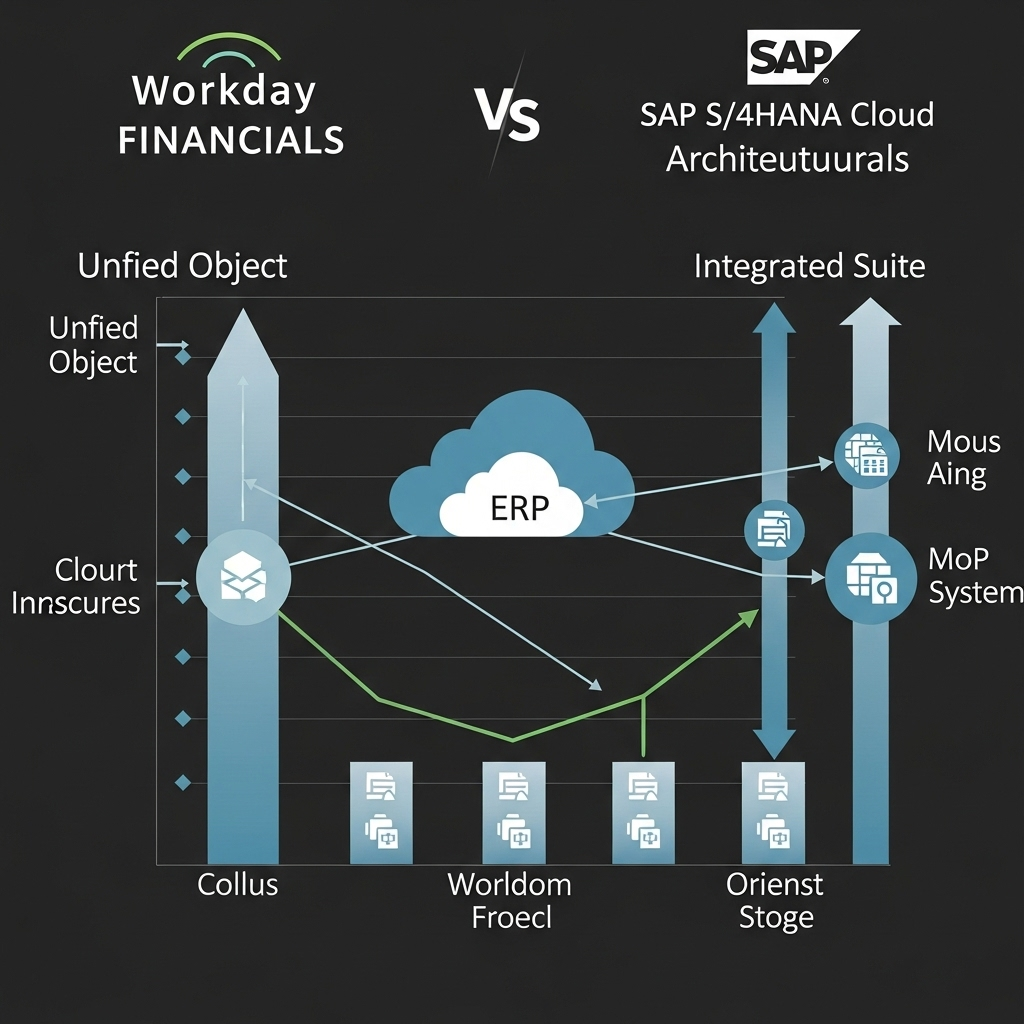
Table of Contents
Selecting a Modern Cloud ERP: Architectural Considerations
Choosing a core financial system is among the most critical technology decisions for large enterprises. In the cloud ERP landscape, Workday Financials and SAP S/4HANA Cloud frequently emerge as leading contenders, particularly for organizations seeking scale, integration, and modern capabilities. While feature comparisons are common, my research suggests a deeper analysis of their fundamental architectures reveals crucial differences impacting long-term flexibility, reporting capabilities, and operational fit.
This analysis focuses specifically on the core architectural distinctions between these two powerful platforms.
Workday’s Unified Object Model
Workday Financials was built from the ground up as a cloud-native application. Its architecture centers around a unified object model and an in-memory processing engine. This means that transactions, master data, and configurations reside within a single, consistent structure. The implications are significant:
- Real-time Reporting: Changes are reflected instantly across the system, eliminating the need for batch processing or data warehousing for core financial reporting.
- Worktags:** This flexible tagging system allows for multi-dimensional analysis without complex chart of accounts structures. Data inherits tags automatically, streamlining reporting across various business dimensions (projects, cost centers, regions, etc.).
- Unified Data: Financials, HCM, and other Workday modules share the same underlying data model, facilitating seamless cross-functional analysis (a significant advantage for service-centric organizations).
This “Power of One” approach emphasizes consistency and real-time visibility, stemming from its clean-slate cloud design.
SAP S/4HANA Cloud’s Integrated Suite
SAP S/4HANA Cloud represents an evolution of SAP’s long-standing ERP dominance, optimized for its in-memory HANA database. Key architectural aspects include:
- Universal Journal:** This central table simplifies the data structure compared to legacy SAP ERP, consolidating financial and controlling data into a single source of truth for financial postings.
- HANA In-Memory Database: Provides significant performance improvements for transactional processing and real-time analytics directly within the ERP.
- Integrated Suite: S/4HANA Cloud excels in environments requiring deep integration with operational processes like manufacturing, supply chain management, and procurement, leveraging SAP’s broader application portfolio.
S/4HANA Cloud’s architecture builds upon established ERP principles, optimized for performance and designed for tight integration across complex operational value chains.
Contrasting Philosophies: Power of One vs. Intelligent Suite
The core difference lies in their architectural starting points. Workday offers a unified, organically built cloud platform, prioritizing data consistency and real-time insights, particularly strong in finance and HR alignment. SAP provides an “Intelligent Suite” where S/4HANA Cloud serves as the digital core, integrating tightly with other specialized SAP cloud applications for broader operational scope.
Workday’s architecture might appeal more to service-based industries or those prioritizing finance/HR transformation. SAP’s architecture often aligns better with complex manufacturing or supply chain-heavy organizations already invested in the SAP ecosystem.
Implementation and Extensibility
Architectural differences also influence implementation and customization:
- Workday: Generally perceived as having a more prescriptive implementation model due to its unified structure. Extensibility often relies on configuration within the platform or integration via APIs.
- SAP S/4HANA Cloud: Offers various deployment options (public, private cloud) and leverages the SAP Business Technology Platform (BTP) for extensions and customizations, providing potentially more flexibility but also requiring potentially more complex management.
Strategic Implications for Finance Leaders
The choice between Workday Financials and SAP S/4HANA Cloud hinges less on individual features and more on strategic alignment with the enterprise’s operating model and existing technology landscape. Understanding their fundamental architectural differences (Workday’s unified object model versus SAP’s integrated suite approach) is crucial for making an informed decision that supports long-term business objectives.
Industry considerations play a crucial role. Manufacturing, distribution, and asset-intensive industries often benefit from SAP’s deep operational integration capabilities. Service-oriented organizations, professional services firms, and those prioritizing finance-HR alignment may find Workday’s unified approach more advantageous.
Existing technology investments significantly influence platform fit. Organizations with substantial SAP investments can leverage existing expertise and integration patterns. Companies seeking to modernize legacy systems or those with diverse ERP landscapes might benefit from Workday’s clean-slate architecture.
Implementation timeline and complexity differ markedly. Workday typically offers more predictable implementation timelines due to its prescriptive approach, while SAP implementations may require more extensive customization but offer greater operational depth.
Both are powerful platforms, but their underlying designs cater to slightly different strategic priorities and organizational contexts.
What factors are most critical in your organization’s ERP evaluation? Share your perspectives with me on LinkedIn.